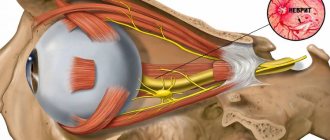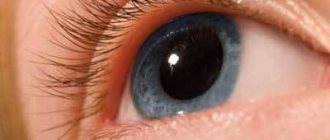Optic neuropathy is a dangerous pathology that can lead to vision loss. The disease is not independent and often becomes a consequence of other diseases. From this article you will learn all the details about this condition: its forms, causes of development, signs, as well as features of diagnosis and further treatment.
In this article
- What is optic neuropathy?
- Symptoms of optic neuropathy
- Anterior ischemic optic neuropathy
- Posterior ischemic optic neuropathy
- Diagnosis of optic neuropathy
- Treatment of optic neuropathy
Causes of the disease
Most often, optic neuritis develops with multiple sclerosis and is its first manifestation. The basis of the inflammatory process in this case is demyelination, or destruction of the myelin sheath of the nerve. Damage to the optic nerve is also provoked by other autoimmune pathologies: systemic lupus erythematosus, Sjogren's syndrome.
Diseases associated with serum immunoglobulin G to myelin-oligodendrocyte glycoprotein (MOG-IgG), in particular acute disseminated encephalomyelitis, also lead to demyelination and, as a consequence, optic neuritis.
Axons and neurons of the optic nerve are destroyed not only as a result of demyelinating processes, but also against the background of other diseases. These include:
- inflammation of the eyeball and/or orbit;
- inflammatory diseases of the brain;
- infectious processes in the nasopharynx;
- sarcoidosis, granulomatosis;
- acute cerebrovascular accident;
- endocrine pathologies – thyrotoxicosis, diabetes mellitus;
- specific infections - tuberculosis, syphilis, influenza.
Optic neuritis can be a consequence of eye injury, traumatic brain injury, toxic damage - in most cases it is poisoning with methyl alcohol, lead, and sometimes helminthic infestations. May be provoked by complicated pregnancy.
Treatment prognosis
Unfortunately, glaucomatous neuropathy is inevitable and it is impossible to completely restore dead optic nerve neurons. But timely seeking medical help and following medical recommendations contribute to maximizing the preservation of a person’s visual function.
People over 50-60 years of age should regularly visit an ophthalmologist, even if they are in good general health and have satisfactory vision.
Surgery is a radical method of treating glaucoma. The decision on the need for surgery is made by the doctor, taking into account the condition of the patient’s visual organs, his general health, age, and the presence of concomitant diseases.
Indications for surgery are the lack of a therapeutic effect with long-term use of medications, rapid progression of the disease, and rapid narrowing of the field of vision. There are several types of surgery for glaucoma, including fistulizing surgery. The choice of type of operation is determined on an individual basis.
Symptoms of optic neuritis
Symptoms vary depending on the type of disease: intrabulbar (papillitis) or retrobulbar neuritis.
Papillitis (intraocular, retrobulbar neuritis)
It is characterized by an acute onset with a rapid deterioration in visual acuity - from 1-2 hours to 1-2 days. In some cases, mild headache and pain when moving the eyes occur. With partial damage, visual acuity may be preserved, but scotomas appear - areas of partial or complete loss of the visual field, which can be central or paracentral, round or arch-like. There may be a narrowing of the boundaries of the visual field, a decrease in dark adaptation and color perception. Most often, symptoms of visual impairment disappear after 7-10 days; after 2-3 weeks (sometimes up to 5 weeks), vision is restored. Without treatment or with severe neuritis, optic nerve atrophy with complete loss of vision is possible.
Retrobulbar neuritis
It occurs in acute or chronic form. The acute form is more often characteristic of unilateral lesions, the chronic form - for bilateral ones.
General symptoms:
- pain when moving the eyeballs and pressing on the eye;
- color vision disorders - decreased sensitivity of the eye to colors, shades quickly fade;
- a drop in visual acuity to the point of complete inability to distinguish objects;
- appearance of scotomas.
Depending on the form of retrobulbar neuritis, symptoms may vary. Axial neuritis is characterized by a combination of central scotoma with partial loss of visual fields and the appearance of peripheral defects in the visual field. In the peripheral form, the field of vision narrows along the entire perimeter - it is concentric in nature. The transversal form is characterized by a significant decrease in vision, up to blindness, scotomas merging with peripheral loss of visual fields.
Symptoms of atrophy
One of the main signs of incipient optic nerve atrophy is an uncorrectable decrease in visual acuity and quality: neither glasses nor contact lenses can compensate for the decrease in visual functions caused by the atrophic process in the nerve. Rapidly progressive optic atrophy can result in complete, incurable blindness within months or even days. With partial atrophy, organic degradation and increasing functional failure of the visual organs stop at a certain level and stabilize (the reasons for such stabilization often also remain unclear).
Visual fields are narrowed, as a rule, due to loss of peripheral (“side”) vision – the so-called tunnel vision syndrome. Color vision disorders concern mainly red-green and yellow-blue gradients of the general spectrum. Scotomas may appear, i.e. blind spots in the field of relatively intact vision.
Fig. 4 Normal vision and with damage to the optic nerve (glaucomatous atrophy)
Quite typical for optical neuropathy is the so-called. pupillary defect: weakening of the pupil's reaction to light while maintaining overall consistency of pupillary reactions. The pupillary defect can be unilateral or detected in both eyes simultaneously. Whatever symptoms accompany optic nerve atrophy, they should only be detected during a professional ophthalmoscopic examination and interpreted by a qualified ophthalmologist.
Classification and stages of disease development
Depending on the affected area:
- Intrabulbar (intraocular) neuritis, optic papillitis. This is an inflammation of the intraocular part (disc) of the optic nerve. More often develops in children.
- Retrobulbar neuritis. Damage to the nerve section lying between the eyeball and the optic chiasm. Forms of retrobulbar neuritisSource: Retrobulbar optic neuritis. Kukhtik S.Yu., Popova M.Yu., Tantsurova K.S. Bulletin of the Council of Young Scientists and Specialists of the Chelyabinsk Region, 2021: axial - a bundle of axons passing in the optic nerve is involved in the pathological process;
- peripheral - inflammation covers the nerve sheaths and spreads deep into the nerve trunk with the formation of a large amount of exudate under the sheaths;
- transversal - the process affects all layers of the optic nerve.
According to the etiology of the lesion:
- infectious:
- parainfectious (post-vaccination, after acute respiratory viral infections);
- demyelinating;
- ischemic;
- toxic;
- autoimmune.
According to the severity of the flow:
- spicy;
- chronic.
According to the prevalence of the lesion:
- mononeuritis – inflammation of one nerve (the vast majority of cases);
- polyneuritis – involvement of both optic nerves in the process (less than 1% of cases).
Diagnosis of the disease
As a rule, patients who have the first symptoms of optic neuritis turn to an ophthalmologist. The disease is considered an interdisciplinary pathology; an ophthalmologist or neurologist must take part in its treatment. If neuritis develops against the background of other pathologies, it is necessary to clarify the diagnosis and carry out specific therapy for the primary diseases. Source: Visualization of the optic nerve in the diagnosis and monitoring of retrobulbar neuritis. Yuryeva T.N., Burlakova E.V., Khudonogov A.A., Ayueva E.K., Sukharchuk O.V. Acta Biomedica Scientifica, 2011. p. 133-136. Then the appropriate specialists are involved in the treatment - an immunologist, an otolaryngologist, an infectious disease specialist, a phthisiatrician.
The first step in diagnosing optic neuritis is collecting anamnesis, external examination of the patient, and palpation. During the medical history, the doctor will clarify the presence of concomitant pathologies, the time of onset of the disease, what complaints the patient has (pain, decreased visual acuity, changes in color perception, the appearance of “blind” spots), how quickly the symptoms developed and how severe they are, whether one eye or both is affected.
External examination and palpation may often not provide additional data. Pain, forward displacement of the eyeball, and limitation of its movements may occur with retrobulbar neuritis, but are not obligatory.
Next, the doctor proceeds to an ophthalmological examination. It includes:
- determination of visual acuity;
- the study of color perception is carried out using Rabkin’s polychromatic tables;
- study of pupil reaction to light;
- measurement of intraocular pressure, which can be a symptom of glaucoma and other diseases that provoke the development of neuritis;
- biomicroscopy – examination of the anterior segment of the eye to exclude its pathology;
- ophthalmoscopy (examination of the fundus of the eye) after instillation of drops that dilate the pupil;
- computer examination of visual fields at 120 points;
- study of visual fields using kinetic perimetry.
To clarify the diagnosis, the following methods are used:
- electrophysiological diagnostics - study of the threshold of electrical sensitivity of the retina and visual evoked potentials;
- ultrasound examination of the eyes, MRI of the orbit of the eye and brain;
- coherence tomography of the optic nerve;
- fluorescein angiography of the retina.
Laboratory diagnostics:
- general blood analysis;
- blood for HIV, syphilis, rheumatoid factor;
- blood culture for sterility;
- PCR studies;
- histological, immunochemical analysis.
If the patient has concomitant diseases, he is prescribed consultations with specialists.
Diagnosis of CHAZN
In addition to visual ophthalmoscopy, any information relating to the premorbid (pre-morbid) period of the patient’s life can acquire decisive diagnostic significance: pharmacological group and dosages of previously taken medications, previous intoxications and common diseases, self-destructive habits (smoking, alcohol abuse, unhealthy lifestyle), experienced TBI (traumatic brain injury), background residual pathology of the central nervous system, etc.
Direct examination includes the establishment or exclusion of exophthalmos (“bulging”, anterior displacement of the eyeball), study of pupillary and corneal reflexes, mobility of the eyeball, general acuity and visual fields (visimetry, perimetry), diagnosis of color perception.
Fig.5 Fundus and visual fields in normal conditions and in patients with PAI
As stated above, one of the most informative diagnostic criteria is the appearance of the optic disc during ophthalmoscopy of the fundus: color, clarity of boundaries, diameter, uniformity, deformation, excavation (“pitting”) of the optic disc surface, Kestenbaum’s symptom (reduction in the usual number of small capillaries by disk), caliber, shade and linearity/tortuosity of the retinal arteries and veins. You may also need an additional tomographic study in one mode or another (laser scanning, optical coherence tomography), an electrophysiological study to measure sensitivity thresholds and lability of the optic nerve. In case of atrophy caused by glaucoma, it is mandatory to measure and control IOP (intraocular pressure), incl. in daily and load modes.
To assess the dynamics of the process and identify the most minor manifestations, our clinic uses OCT - optical coherence tomography: a non-contact and fast, but very accurate diagnostic procedure. It is possible to conduct research in angiography mode!
Fig. 6 Results of OCT (optical coherence tomography) of the optic nerve head
Volumetric orbital oncopathology is diagnosed using plain radiography. If a detailed study of circulation and hemodynamics in the vascular system is necessary, fluorescein angiography (one of the methods of contrast radiography) and/or Doppler ultrasound is prescribed. Recently, OCTA has appeared - optical coherence tomography angiography, also available in our clinic.[5]
For the purpose of clarifying diagnostics, consultants of related specialties are involved, primarily neurologists, oncologists, neurosurgeons, and in the presence of systemic vasculitis - rheumatologists, etc.; Imaging methods for studying the skull and brain (radiography, CT, MRI) are prescribed.
Occlusions of retinal vessels (arteries, veins) require the involvement of a vascular surgeon. If infectious symptoms are present, laboratory tests (ELISA, PCR) are prescribed.
Optic atrophy should be differentiated from peripheral cataracts (clouding of the lens) and amblyopia (“lazy eye syndrome”).
Treatment of optic neuritis
Treatment must be carried out in a hospital setting; it should begin as early as possible, in order to avoid the disease becoming chronic and developing complications. Source: Modern view on the problem of optic neuritis (systematic review). Krivosheeva M.S., Ioileva E.E. Saratov Scientific and Medical Journal, 2021. p. 602-605. For patients with optic neuritis, diet No. 15 is indicated - a general table, in the absence of indications for other types of therapeutic diets.
The basis of treatment is etiotropic therapy aimed at eliminating the primary disease that caused optic neuritis. Until the etiology of the disease is clarified, remedies are used to reduce the symptoms of inflammation, remove swelling, allergic manifestations, and improve metabolism. For this purpose:
- glucocorticosteroid drugs, if they are intolerant - non-steroidal anti-inflammatory drugs (prescribed in rare cases);
- antibacterial or antiviral therapy;
- antifungal agents to prevent fungal infection due to a long course of antibiotics;
- detoxification therapy – intravenous drip administration of saline solutions;
- antihistamines;
- diuretics;
- products that improve microcirculation;
- neuroprotectors;
- vitamins.
In addition to medications, physical therapy may be used to treat optic neuritis.
With papillitis, as well as the infectious-toxic etiology of the disease, the prognosis is more favorable than with other types of optic neuritis - in 75-90% of cases, with proper treatment, vision is completely restored. When the optic nerve is damaged due to autoimmune, demyelinating diseases, collagenosis, sarcoidosis, and specific infections, relapses often occur, incomplete restoration of vision, and nerve atrophy is possible. Source: Results of treatment of optic neuritis. Latypova E.A. Saratov Scientific and Medical Journal, 2021. p. 875-879.
Treatment methods for ischemic conditions of the optic nerve and retina
and optic nerve conditions TO Eliseeva, AV Svirin Authors examine in details peculiarities of pathogenesis of ischemic eye diseases and methods of their treatment.
Currently, there is a significant increase in the number of people of working age suffering from hypertension, atherosclerosis, coronary artery disease and diabetes mellitus. These diseases are often accompanied by circulatory disorders in the retinal vessels and vessels supplying the optic nerve, age-related degenerative changes, etc. A significant percentage of such patients become disabled. The most common basis of pathology in these diseases is ischemia. The risk of developing ischemic conditions of the eye is due to the anatomical features of the microvasculature and to a certain extent depends on the degree of development of collateral circulation, which exists in the prelaminar, laminar and postlaminar sections of the optic nerve [11, 15]. General characteristics of ischemic eye diseases There is currently no classification of ocular ischemia. The presence of a close relationship between lesions of various parts of the circulatory system, as well as between the mechanisms of development of ischemia, does not allow a clear division of ischemic processes in the eye according to etiological and pathogenetic characteristics. Due to the fact that ischemic diseases of the eye are multi-etiological, have different pathogenesis and a multifaceted clinical picture, it is difficult to imagine a perfect classification. It is only possible to clearly divide all ischemic processes in the eye into acute and chronic. Dystrophic changes in the retina are among the most severe eye lesions. They occur in both young and old people and are often characterized by a progressive course, leading to a decrease in visual function and often to disability. The question of the classification of degenerations has not been finally resolved. Without going into a discussion of existing classifications, as a working option it is advisable to take as a basis the proposal of Duke-Elder (1967), dividing all dystrophic changes in the retina into degenerations primarily associated with impaired vascular circulation in the choriocapillaris layer and retinal vessels, and hereditarily determined lesions and degenerations . In the first group of diseases, chronic ischemia is the main pathogenetic link. In the second group of retinal degenerations, the ischemic component is secondary. But when selecting a treatment complex, it is very important to take its presence into account. Severe degenerative, dystrophic changes in the retina include lesions in the macular region. Such lesions are observed in 25–40% of patients, more often in the elderly. This is explained by the fact that the macular area is generally in worse nutritional conditions than the peripheral parts of the retina. In the pathogenesis of age-related macular degeneration, sclerotic changes in the choroidal vessels and hemodynamic changes in the orbital artery, which can be observed both in arterial hypertension and hypotension, are important. Hoyng (1998) found that 1% of patients with senile central macular degeneration become practically blind by the age of 65–74 years, with visual acuity of 0.01–0.02. In the age group over 85 years, the number of blind people among such patients reaches 11%. A significant problem is the treatment of glaucomatous optic atrophy. Most ophthalmologists believe that optic atrophy is largely due to circulatory problems. This problem becomes particularly acute in the treatment of advanced forms of glaucoma, when vascular disorders, often combined with this eye disease (atherosclerosis, hypertension or diabetes mellitus), lead to an acute deficiency of blood supply, and compensatory possibilities are completely exhausted [3, 17]. After surgical treatment in such patients, it is most often possible to normalize IOP. However, long-term results of the study show that the decline in visual functions continues, despite the normalization of IOP [1, 12]. Acute ischemia of the posterior segment of the eye manifests itself in the form of circulatory disorders in the central nervous system and its branches, anterior and posterior ischemic neuropathy. It may be a consequence of existing chronic ocular ischemia (diabetic or hypertensive angioretinopathy, degenerative changes in the retina, stenosis of the carotid, orbital arteries, temporal arteritis). Arterial blood flow disorders may also be caused by general angiospastic diseases and eyeball injuries. Cases of the development of ischemic neuropathy and circulatory disorders in the central nervous system and branches have been described against the background of hypotension, taking certain medications and after heart surgery (predisposing risk factors in this case are hypothermia, anemia, increased IOP and microembolization) [31, 35]. Spontaneous recovery from ischemic neuropathy occurs in a small proportion of cases [29, 30]. Acute circulatory disorders in the retina and optic nerve in almost all cases lead to partial loss of vision, and in some cases to complete blindness. The prognosis for vascular diseases of the optic nerve is always serious, but not hopeless. Sometimes, under the influence of treatment, improvement or stabilization of the disease process may occur. However, it is not always persistent, so repeated treatment in the form of regular courses is required. Visual acuity increases by 0.1–0.2, but in all cases defects remain in the visual field. When patients present late, visual acuity does not change or may even decrease. Often, ischemic optovascular syndrome is a harbinger of ischemic coronary or cerebral incidents and therefore requires careful long-term treatment not only of the eye disease, but also of accompanying diseases [22]. Issues of pathophysiology of ischemic conditions of the eye According to the functional principle of classification of the vascular bed, several groups of vessels are distinguished. The condition of each of them can affect blood circulation in the eye [23]. The common carotid artery, which supplies the orbit and eye with blood, belongs to the group of high-pressure vessels that have high distensibility and convert the rhythmic release of blood into a uniform flow [9, 22]. Small arteries and veins (these include the orbital artery) are pressure stabilizers. They have a developed smooth muscle membrane, stretch little, providing a certain basal tone, responding to numerous, mainly local, factors regulating regional blood flow. The branches of the CAS of the first and second order, large choroidal arterioles, ciliary arteries, being distributors of capillary blood flow, block the blood flow in the capillary during contraction and resume it when relaxing. The exchange function between blood and tissues is provided by exchange vessels - capillaries and post-capillary veins. In this regard, they have significant structural features. The retinal capillaries create an internal blood barrier. The walls of the capillaries of the optic disc and retina are not fenestrated. They have a dense internal lining of endothelial cells, which only allow fat-soluble substances (oxygen, CO2) to pass through. Transport of water-soluble structures is carried out by micropinocytic vesicles of the endothelium (by filling the endothelial pores with water). Of great importance for the functioning of the retina is that it has two capillary networks: a superficial one, located in the layer of nerve fibers, and a deep one, located between the inner nuclear and outer plexiform layers. There are anastomoses between them [7]. To a large extent, microcirculation and transcapillary exchange processes are influenced by the state of post-capillary resistance vessels. These include venules and small veins. Active or passive changes in their lumen lead to the accumulation of blood or to its emergency release into the circulation. The retina has only a venous type of outflow. Shunt vessels, which are various types of anastomoses that connect arterioles and venules, bypassing the capillary network, are of particular importance, especially in case of circulatory disorders in the retina. They play a significant role in the development of the “steal” syndrome. Three pathophysiological links can be distinguished in the development of vascular ischemic diseases of the eye [2, 20, 25]. • Central circulatory disorders (caused by diseases of the heart, large vessels that maintain systemic blood pressure and the direction of its movement). One of the first places among the etiological factors of acute ischemic conditions of the eye (ischemic neuropathy, circulatory disorders in the vessels of the retina) is occupied by hypertension and atherosclerosis [11, 33, 34]. These and other vascular diseases, as well as age-related weakening of the heart, aggravate the course of glaucoma even with normalization of IOP. In ophthalmology, there is even a concept about the primacy of the vascular factor in the development of glaucoma. Diseases of the heart and large vessels can contribute to optic atrophy and age-related retinal degeneration. • Violation of organ tissue circulation (local, regional, peripheral). Ischemia (along with arterial and venous hyperemia and stasis) is the most common form of pathology of regional circulation. There are two main reasons for the development of ischemia - a decrease in arterial blood flow and an increase in tissue consumption of oxygen and metabolic substrates transported by blood. Ocular ischemia is usually caused by a lack of blood flow, which may result from one or more mechanisms. Three mechanisms most often lead to a decrease in blood flow: 1. Neurogenic. Vasoconstriction occurs against the background of the predominance of sympathoadrenal influences on arterioles and precapillaries (stress), as well as due to a decrease in the activity of parasympathetic influences on arterioles (neuroparalytic ischemia). 2. The humoral mechanism of constriction of arterioles is associated with an increase in the content in tissues of agents with a vasoconstrictor effect (angiotensin II, vasopressin, catecholamines) and (or) with an increase in the sensitivity of the vascular wall to them (with the accumulation of sodium and calcium ions in it). 3. The “mechanical” genesis of ischemia is due to the presence of an obstruction to the blood flow through the arterioles due to: a) compression of the vessel (tumor, scar, tissue edema, rarely - long-term compression of the central nervous system or optic nerve, as a result of operations performed for retinal detachment with cerclage or scleroplasty regarding myopia), as well as compression of vessels in the optic disc due to deformation of the cribriform plate in glaucoma, b) reduction of the lumen of arterioles, up to complete closure (embolus, thrombus, aggregate of blood cells) [20]. • Impaired blood circulation in the vessels of the microvasculature (occurs in arterioles, precapillaries, capillaries, postcapillaries, venules and arteriolovenular shunts). Microcirculation is understood as the orderly movement of blood and lymph through microvessels, the transcapillary exchange of oxygen, carbon dioxide, substrates and metabolic products, ions, biologically active substances, as well as the movement of fluids in the extravascular space [20]. The conditions of blood circulation in the microvasculature (MCR) have their own characteristics due to the presence of an extremely branched network of small-caliber vessels and precapillary sphincters. Moreover, the diameter of the capillaries does not correspond to the size of the erythrocyte [7, 14]. As a result, resistance to blood flow in the MCB is largely determined by the state of the precapillary sphincters and the rheological properties of the blood. The consequences of ischemia are hypoxia, an excess of products of impaired metabolism, ions and some biologically active substances that accumulate in ischemic tissue (lactic acid, thromboxane A, free radicals, calcium ions). This leads to a decrease in the specific functions of the organ, a decrease in nonspecific functions and processes (local protective reactions, cell proliferation and differentiation), the development of dystrophic processes, tissue hypotrophy and atrophy [20]. But the outcome and nature of the consequences of ocular ischemia can be different and depend on a number of factors. The most significant for the eye are the rate of development of ischemia, the diameter of the affected artery or arteriole, the state of the vascular network of the eye (the presence of angiosclerosis, involution processes in the vessel wall), as well as the degree of development of collateral vessels and the rate of activation of collateral circulation. The inclusion of collateral circulation is facilitated by the presence of pressure gradients proximal and distal to the area of narrowing, the accumulation or introduction into the ischemic zone of biologically active substances with a vasodilating effect, and the degree of development of the vascular network in the affected eye. Methods of treatment of ischemic conditions of the eye Issues of treatment of ischemic conditions of the eye are sufficiently covered in the literature in relation to diseases such as glaucoma (compensated), age-related central retinal degeneration, anterior and posterior ischemic neuropathy, circulatory disorders in the branches of the central nervous system, atrophy of the optic nerve of vascular origin. The most developed methods of conservative treatment include pharmacotherapy and physical therapy. But in this article we want to analyze existing methods of surgical treatment of ischemic diseases of the optic nerve and retina. The instability and short duration of the effect after the use of vasodilator drugs in combination with other medications and physiotherapeutic treatments led ophthalmologists to search for more permanent ways to improve blood circulation in the eye. Various surgical methods have been developed to correct impaired blood circulation in the eye. All operations to improve the hemodynamics of the retina and optic nerve are divided into three groups [3]: I. Methods of revascularization of the posterior part of the eye using extraocular muscles, episcleral tissue and implants in Tenon’s space. II. Operations on vessels involved in the blood supply to the eye. • By redistributing blood flow in the internal carotid artery and ophthalmic artery. • By slowing down the outflow of venous blood - phlebodestruction. III. Decompression surgery on the optic nerve. Revascularization of the posterior part of the eye Revascularization of the choroid has been widely used by many ophthalmologists. There are many modifications of these operations, the general direction of which is to create additional collateral blood supply to the inner membranes of the eye. The operations were performed using extraocular muscles and an episcleral flap [5, 10]. For dystrophic diseases of the retina, chondroplasty was also used using autocartilage from the patient's auricle. V.S. Belyaev (1983) introduced pieces of donor sclera into Tenon's space with simultaneous microdiathermocoagulation of the recipient's sclera, which subsequently contributed to the thinning of the sclera and the appearance of newly formed vessels. The stimulating effect of materials introduced into Tenon's space is explained by the release of vasoactive and other physiologically active substances (histamine, serotonin, kinins, lysosomal enzymes, etc.). The development of an immune response leads to increased vascularization of the optic nerve and other eye tissues. The formation of bradykinin and histamine leads to vasodilation and increased local blood flow. At the same time, mast cells begin to produce heparin, which has a beneficial effect on microcirculation [4]. Morphological studies confirmed the presence in the surgical area of a large number of newly formed capillaries in the episclera, optic nerve sheaths and other eye tissues [3, 4]. For local administration of drugs to the posterior segment of the eye, retrobulbar injections or electrophoresis are mainly used. In this case, a significant part of the administered medication is absorbed into the capillaries of the fatty tissue of the orbit and goes into the general vascular bed. Due to the painfulness of the procedure, it is not advisable to administer drugs retrobulbarly several times a day; in addition, there is a risk of hematoma or damage to the optic nerve or eyeball with an injection needle. In order to maintain a high concentration of the drug in direct contact with the vessels of the sclera and optic nerve in the posterior segment of the A.P. Nesterov and S.N. Basinsky proposed the introduction of a collagen infusion system into Tenon’s space [3, 18, 19]. Collagen is the main structural protein of connective tissue, insoluble in conventional solvents. In medicine, filmy and spongy collagen materials are most widely used as wound coverings. Medical and biological studies of collagen preparations have revealed a number of their valuable properties: non-toxicity, lack of local tissue sensitization and a reduced likelihood of allergic reactions due to their low antigenicity. The excellent compatibility of collagen with various medicinal substances makes it possible to obtain drugs and materials with targeted action [19]. Subtenone implantation of the collagen infusion system (Sikis) is that with the help of a silicone tube, hemdered to a collagen transplant, you can introduce the necessary drugs directly to the rear pole of the eye 2-3 times a day. The operation of the operation was described earlier and consists of two stages. From a standard sterile collagen sponge 10 mm thick, a 30 mm length and a width of 8 mm is formed (Fig. 1). The flap of a collagen sponge is wetted in a physiological solution, squeezed, folded in half. One end of the polyethylene tube is 10–12 cm long and 1–1.5 mm in diameter is located inside the folded sponge and stitched with a mattress seam 8/0 so that the thread passes through the tube. The hole on the other end of the tube is tightly closed with a sterile corruption (Fig. 2). The conjunctiva section and a tenon capsule are produced 6–7 mm from the limit in the upper - tuning quadrant. A channel is formed by a spatula through the incision in the tenon space to the rear pole of the eye (Fig. 3). The prepared infusion system is introduced into the formed channel (Fig. 4). On the incision, the conjunctiva and capsules apply a continuous seam. The bred pipe is fixed on the skin of the forehead with adhesive plasters (Fig. 5). With Sikis, the drug impregnated through the tube impregnates the pores of the sponge and partially spreads through the tenon space. The porous structure of the sponge provides the creation of a kind of depot. In addition, there is data on the prolonging effect of the collagen sponge on the effect of drugs [7, 10]. The presence of a tube allows you to administer drugs 2 or more times a day. The duration of treatment with Sikis can be provided up to 10-14 days, provided that the sterility of the tube itself is maintained. At the end of the treatment, the tube is easily removed by sipping at the outer end. Cutting the conjunctiva zone is not required. According to A.P. Nesterova, A.V. Svirina and S.N. Basinsky, as a result of the use of the Sikis method in patients with glaucoma, atrophy of the optic nerve, the retinal pigmented abytrophia, was achieved in most cases in most cases in the first days after operations [18, 19]. Stabilization of visual functions has been observed over the next 6 months. Sikis operation can be performed repeatedly, but not earlier than 2-3 months after the previous operation. Operations on the vessels involved in the blood supply to the eye methods of redistributing blood flow in the eye for the first time, this type of operation was proposed in 1968 and consisted of dressing the external carotid artery. This led to an increase in trunk blood flow in the orbital artery, increased blood supply to the vascular membrane and activation of metabolic processes in the retina and visual nerve. However, this operation had a number of serious shortcomings: the impossibility of conducting the internal carotid artery, a large pressure of the blood in the internal carotid artery after surgery, the need to use carotid angiography [3]. Therefore, operations were developed to cross the branches of the orbital artery, as well as the surface temporal and angular arteries (branch of the external carotid artery) [27]. Studies have shown the possibility of improving and stabilizing visual functions in patients with various forms of vascular pathology. However, the implementation of vasorescent operations is advisable in a certain contingent of patients and depends on the data of ultrasound dopplerography and fluorescence angiography [27]. If the blood supply to the eye is a normal or compression test does not increase the blood flow in the orbital artery, then this surgical intervention is not shown. The severity of the effect of surgery and the stability of the results depend on the stage of the disease. The FLEBODECTION Operation in 1984 M.Bonnet published work in which he proposed the survey of vorticous veins with retinal dystrophy. The operation began to be used in Russia, with a positive effect. The purpose of the operation is to create conditions for a more slow passage of arterial blood through the pectyllar arterioles to improve the irrigation of the macular zone, which leads to longer contacts of erythrocytes with the choriocapillars endotheliers. Decompression operations on the membranes and the scleral canal of the optic nerve this method of surgical treatment has become widespread with atrophy of the optic nerve of vascular genesis. In 1972, J.Vasko - Posada for the treatment of thrombosis and embolism of the main vessels of the retina, the operation of decompression - dissecting the solid cerebral membrane of the optic nerve and the posterior scleral ring later began to be used by many ophthalmologists for the treatment of ischemic neuropathy, Occlusias and in glaucoma. The latter is due to the fact that a progressive drop in vision is often observed, despite compensation for IOA. According to studies of various authors, the most vulnerable are the prelaminating and laminar parts of the optic nerve located in the scleral canal. The scleral ring that impresses the channel in the lumen, narrows it in half. In this zone, glaucomatous excavation is formed, the nerve fibers are squeezed to the periphery of the canal and bend through the edge of the scleral ring. Based on this, various modifications of decompression operations were proposed, the essence of which is to dissect the scleral ring, which leads to a decrease in the compression of the nerve fibers in the scleral canal [12, 13]. However, a significant outrage and traction of the optic nerve can be the cause of serious complications (including circulatory disorders in the vessels of the retina and optic nerve). Foreign ophthalmologists relatively widely use the fenestation of the optic nerve shell to treat the anterior and posterior ischemic neuropathies of non -inflammatory genesis [34]. In acute ischemic neuropathies, a vicious circle forms. Circulatory disorders cause fiber edema, an increase in tissue pressure, which, in turn, leads to a further increase in circulatory disorders (violation of venous outflow, permeability violation). If local edema is treated at an early stage, then this vicious circle can be broken and you can prevent secondary tissue damage. This was the reason for the proposal of the surgical dissection of the prelaminar part of the optic nerve shell. However, the same effect can be achieved in the acute stage of the use of corticosteroids, which increase the content of substances that prevent the action of hyaluronidase, thereby reducing the permeability of the vascular wall. Data on the results of the fenestance of the shell of the TNS are contradictory. This is due to the difficulty of accounting and statistical processing in all parameters affecting the result of treatment (age groups, concomitant diseases, the prescription of the process, observation time, etc.). The conclusion thus, evaluating the data of literature regarding the treatment of ischemic diseases of the opposite nerve and retina, it should be noted that in this area there are a number of issues requiring further study. The search for the most effective vasoactive drugs with minimal side effects continues. Many ophthalmologists pay great attention to the improvement of old and the development of new methods of surgical treatment of ischemic processes in the eye. The use of a number of methods in the complex treatment of ischemia and its consequences (hypoxia, excess products of impaired metabolism, tissue dystrophy) can improve the hemodynamics of the eye and maintain visual functions.
References 1. Abramov V.G., Zherdetsky A.S., Sirota G.M. On the long-term state of visual functions in persons with normalized ophthalmotonus, operated on for open-angle advanced glaucoma // Physiology and pathology of intraocular pressure / Ed. A.P. Nesterova. – M. – 1990. – P. 61–66. 2. Alekseev O.V. Microcirculatory hemostasis. - In the book. Hemostasis. – M. – 1981. – P.419–460. 3. Basinsky S.N. Changes in hemodynamics in patients with open-angle glaucoma and their correction. – Dissertation of Doctor of Medical Sciences. – 1991. – 248 p. 4. Basinsky S.N., Shtilerman A.L., Sasko V.I. Changes in the hemocirculatory bed in the posterior part of the eye with the introduction of certain drugs into Tenon’s space // Questions of morphogenesis of the vascular system. - Blagoveshchensk. – 1989. – P.59–61. 5. Belyaev V.S. Operations on the cornea and sclera. – M. – 1984. – 143 p. 6. Belyaev V.S., Gossen Zh.H., On the possibility of surgical treatment and prevention of dystrophy of the retina and optic nerve.//Vestn.oftalmol.–1983.– No. 6.– P. 18–21. 7. Bunin A.Ya., Katsnelson L.A., Yakovlev A.A. Microcirculation of the eye. – M. –1984. – 176 p. 8. Voloshinov D.B., Voloshinova M.D. Observation of a positive result in the treatment of acute obstruction of the central retinal artery using a new surgical method. // Ophthalmol. magazine. – 1984. – N.7. – P.443–444. 9. Gabrilyan E.S., Amroyan E.A., Akopov S.E. Physiology and pharmacology of the vascular wall. - Yerevan. – 1987. – 279 p. 10. Indeykin E.N. Choroidal revascularization in advanced glaucoma // Ophthalmol. magazine. – 1980. – P.379–380. 11. Katsnelson L.A., Forofonova T.I., Bunin A.Ya. Vascular diseases of the eyes. – M. –1990. – 272 p. 12. Krasnov M.M., Shmyreva V.F., Pereverzina O.K., Shershnev V.V. Prospects for the use of decompression operations on the optic nerve for atrophies of vascular origin. //Vestn.oftalmol.– 1990.– T.106.– No. 4.– P.22–24. 13. Krasnov M.M., Shmyreva V.F., Mostovoy E.N. Decompression surgery on the optic nerve for glaucomatous atrophy. //Current issues of pathology of the posterior part of the eye. Abstracts of reports. – Odessa – 1989.– pp. 159–160. 14. Kupriyanov V.V., Karaganov Ya.L., Kozlov V.I. Microcirculatory bed. – M.: Medicine. – 1975. – 214 p. 15. Libman E.S., Shakhova E.V. Epidemiological aspects of disability due to vascular lesions of the retina // Current issues in fundus pathology. – M. – 1997. – P.16–18. 16. Lysenko V.S., Mukha A.I. Results of phlebodestruction surgery and hemorheological parameters in patients with central chorioretinal dystrophy // Vestn.oftalmol. – 1991.– T.107.– No. 6.– P.26–28. 17. Nesterov A.P. Glaucoma. – M. – 1995. – 256 p. 18. Nesterov A.P., Basinsky S.N. A new method of administering drugs into the posterior part of Tenon’s space // Vestn.oftalmol. – 1991.– No. 5.– P. 11–14. 19. Nesterov A.P., Svirin A.V., Basinsky S.N., Isaev A.M. The use of collagen sponge preparations in ophthalmic surgery // Methodological recommendations. – M. – 1998. – 17 p. 20. Pathophysiology / Ed. P.F. Litvitsky. – M.: Medicine. –1995. – 751s. 21. Svirin A.V., Milovanova Z.P., Stranov L.P. Anam Z.A. Experimental evaluation of implantation of collagen-based drugs into Tenon’s space of the eye. Physiology and pathology of intraocular pressure. – M. – 1987. – pp. 114–121. 22. Semina E. Retrobulbar neuritis syndrome. – M. – 1994. – 156 p. 23. Folkov B., Neil E. Blood circulation. M.: Medicine. – 1976.– 463 p. 24. Cheglakov Yu.A., Melnikova T.V. New xenograft for the treatment of patients with “dry” involutional chorioretinal macular degeneration // Current issues in fundus pathology. – M. – 1997. – P. 94–96. 25. Chernukh A.M., Aleksandrov P.N., Alekseev O.V. Microcirculation. – M. – 1975.–456 p. 26. Shilkin G.A., Andreytsev A.N., Volodin V.P. Anatomical rationale for the use of the superficial temporal artery for revascularization of the eye and visual pathways // Prevention, medical rehabilitation of blindness and low vision. - Ufa. – 1979. – P. 55–57. 27. Shilkin G.A., Yartseva N.S., Mironova E. et al. Results of intersection of the superficial temporal artery in patients with preglaucoma and early open-angle glaucoma // Ophthalmol. magazine. – 1989. – No. 2. – P.93–96. 28. Shmyreva V.F., Mostovoy E.N., Shershnev V.V. Decompression surgery on the optic nerve as a method of treating optic nerve atrophy in patients with glaucoma // Glaucoma. – 1996.– P.353–356. 29. Aiello AL, Sadum AA, Feldon SE Spontaneous improvement of progressive anterior ischemic optic neuropathy: report of two cases (letter) // Arch. Ophthalmol. – 1992. – Vol.110. – N.9. – P.1197–1199. 30. Barrett DA, Glasser JS, Schotz NJ, Winterkorn JM Spontaneous recovery of vision in progressive anterior ischemic optic neuropathy // J. Clin. Neuroophthalmol. – 1992. – Vol.12. – N.4. – P.219–225. 31. Beck RW, Savino PJ, Schatz NJ et al. Anterior ischemic optic neuropathy: recurrent episodes in the same eye // Brit. J. Ophthalmology. – 1983.– Vol.67. – N. 10. – P.756–769. 32. Bonnet M. Occlussion chirurgicale de 2 yeines vortiqueses dans le traitement des degenerescences maculaires seniles decompensees // J. Franc. Ophthal. – 1984. – Vol. 7. – P.563–567. 33. Hayreh SS, Joos KM, Podhajsky PA, Long CR Systemic diseases associated with nonarteritic anterior ischemic optic neuropathy // Am. J. Ophthalmol. – 1994. – Dec 15. – N. 118. – P. 766–780. 34. Kay MC Ischemic optic neuropathy. Neurol.// Clin.–1991. Feb. 9(1).– P.115–129. 35. Segato T., Midena E., Blarzino MC Age–related macular degeneration // Aging. Milano. – 1993. – Vol. 5. – N.3. – P. 165–176.
Disease prevention
To prevent optic neuritis, it is recommended to give up bad habits, promptly treat infectious diseases, avoid eye and head injuries, and visit specialized doctors in the presence of chronic pathologies.
Article sources:
- Retrobulbar optic neuritis. Kukhtik S.Yu., Popova M.Yu., Tantsurova K.S. Bulletin of the Council of Young Scientists and Specialists of the Chelyabinsk Region, 2016
- Visualization of the optic nerve in the diagnosis and monitoring of retrobulbar neuritis. Yuryeva T.N., Burlakova E.V., Khudonogov A.A., Ayueva E.K., Sukharchuk O.V. Acta Biomedica Scientifica, 2011. p. 133-136
- Modern view on the problem of optic neuritis (systematic review). Krivosheeva M.S., Ioileva E.E. Saratov Scientific and Medical Journal, 2021. p. 602-605
- Results of treatment of optic neuritis. Latypova E.A. Saratov Scientific and Medical Journal, 2021. p. 875-879
Doctors' forecast
Statistics are not encouraging with cases of 100% recovery from optic nerve neuropathy. Optical pathology is partially eliminated with early diagnosis and timely treatment. Ideally, you can count on no recurrence of the disease in the future. Visual acuity will never correspond to the norm, but a person will still be able to see. The situation is worse with the chronic form of optic neuropathy, in which the progression of the disease is steadily increasing.
Prevention of relapse in the form of neurodegeneration will help smooth out the symptoms of the pathology. The patient needs to undergo ongoing maintenance therapy under the supervision of several specialists.











